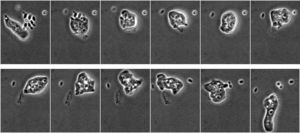Acrasids
A Microbial Biorealm page on the Acrasids

Classification
Higher order taxa:
Eukaryota; Heterolobosea
Species:
Acrasis rosea
Description and Significance
The acrasids are a group of cellular protists which resemble fungi, but are only distantly related, in a different phylum. A small group of protists, they are commonly referred to as slime moulds. The slime mould category encompasses several groups, both uni- and multicellular, some of which are related more closely to the fungi; also see Dictiostelium. Acrasida's Compared to other slime molds, acrasids have several differentiating characteristics: acrasids have much larger amoeboid cells, faster locomotion, and may not utilize chemotaxis when they form fruiting bodies. The acrasids' ultrastructural characteristics are more similar to those of Schizopyrenida, a group of free-living unicellular amoebas. For this reason, the class Heterolobosea was created to properly classify the acrasids and the schizopyrenids (amoeboflagellates). Members of Heterolobosea usually take on two forms during their life cycle: the amoeboid and the flagellate form, the latter of which the acrasids do not take.
Genome Structure
According to NCBI's GenBank, only one of Acrasis rosea's rRNA genes has been completely sequenced.
Cell Structure and Metabolism
Acrasida's cells are heterotrophic and ameboid, able to move and feed using temporary projections called pseudopods (false feet). They are typically roughly cylindrical, with a clear pseudopod at the front, and contain a single nucleus. Under certain conditions, chemical signals from the cells may cause them to accumulate into a mass, with individual nuclei separated by their plasma membranes. This sluglike mass, called a pseudoplasmodium, moves to a better location on its pseudopods and then develops a stalklike formation, called sporangia, in which reproductive spores are produced. The spores germinate, releasing amoeboid cells, which are reproduced through mitosis. Acrasids spend most of their life as individual cells, feeding on bacteria, yeasts, and decaying vegetation. To see an example of Acrasis rosea's locomotion, click here. If conditions become unfavorable to continue on their own, the cells will again merge to form the pseudoplasmodium.
Life Cycle of Slime Mold
Ecology
Acrasids can be found in dung, wood, decaying vegetation, and soil. They are primarily decomposers but also consumers in their ecosystem, as they eat bacteria, organic matter, and tiny organisms. Acrasids and other slime moulds digest waste materials and provide plants with nutrients.
Typical Sporangia of Slime Mould
References
Acrasid Locomotion . Maciver Lab Web Page.
Classification of the Protozoa . Biological and Physical Sciences, Kennesaw State University.
Focus Topic: Plasmodial and Cellular Slime Molds . University of Edinburgh.
Introduction to the 'Slime Molds' . Museum of Palentology, University of California, Berkeley.
Protists and the Origin of Eukaryotes . Biology Dept., University of Winnipeg.
Slime Molds . Pearson College.
The Heterolobosea and related amoeba . University of Edinburgh.


